Lankan greats prophetic on Hughes accident
November 25, 2014, a Tuesday, will be a day the cricket community and the whole world never would, but wish to forget. It’s the day that Australia opener Philip Joel Hughes, opening for South Australia against New South Wales in a Sheffield Shield match, lost his life prematurely at the famed Sydney Cricket Ground.
Hughes, who was well equipped with protective gear, was hit in the back of the neck by a bouncer by Sean Abbott in the 49th over and dropped dazed onto the ground. He was immediately hospitalized but died two days later on November 27, just three days before his 26th birthday.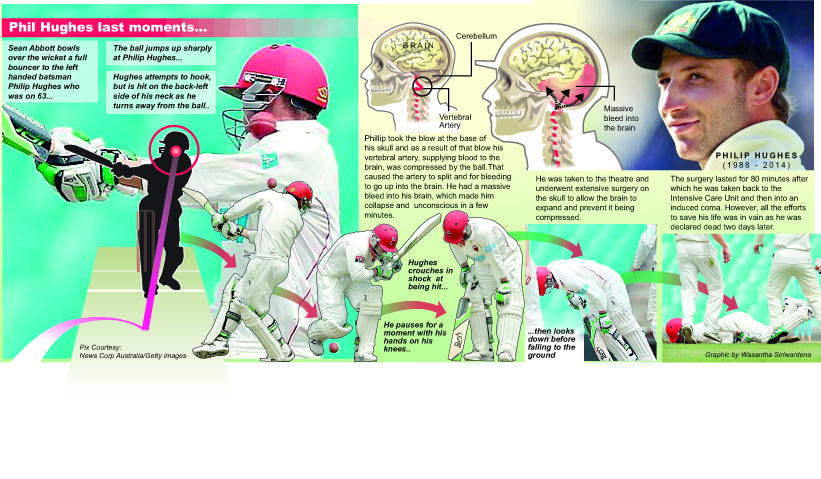
After the tragic incident, which has turned out to be a sensitive subject to discuss, many were critical on the safety of the protective helmets that batsmen wear. Since the beginning of cricket in the 1500s and the incarnation of modern cricket in the late 1800s, around 13 such incidents, inclusive of Hughes’ has been reported so far. Hughes’ fatal incident becomes the fifth and the latest where a batsman lost his life while at the crease.
With the standard of protective gear being upgraded and standardized every now and then veterans of the game, who have represented Sri Lanka at the highest level were articulate that the protective helmet was perfectly fine and if it had to be blamed for the untimely demise of Hughes, it is unreasonable.
“What happened to Phil Hughes was really an unfortunate and rare incident in cricket. I wish that it should have never happened,” stated former Sri Lanka captain Arjuna Ranatunga.
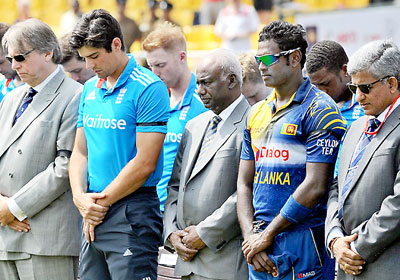
England cricket captain Alastair Cook (2L) and Sri Lanka captain Angelo Mathews (2R) and officials observe a minute's silence in memory of young Australian batsman Phillip Hughes who died after being hit by a ball during a domestic cricket match in Sydney, during the second One Day International (ODI) match between Sri Lanka and England at the R. Premadasa Cricket Stadium in Colombo on November 29, 2014. AFP
“With my experience I see it in two perspectives. In baseball we see that the protection area of the helmet has been altered with more coverings concerning the safety of its players. But then in cricket we had batsmen in the calibre of Sir Vivian Richards, who never used a helmet during his glittering career. What is depicted here is that a batsman is fully in control of his shots and is fully concentrating on the delivery. You cannot blame the helmet or its design as its job is to safeguard the face and head of the batsman.”
Just as much as Ranatunga, former Sri Lanka cricketers Sidath Wettimuny and Michael Tissera were of the view that modern day cricketers, batsmen in general, tent to relax too much knowing that they are wrapped around with gear like pads, guards and helmets. While grieving Hughes’ untimely loss, Ranatunga went on to say that batsmen in the middle should be more cautious.
“This is a bad attitude because batsmen take this gear for granted when it comes to safety. It’s the total responsibility of the batsman to watch each ball, concentrate and handle the situation. With what I see the helmets are in no need of any development or alteration. But it has to be well maintained and changed at the correct time. But there are many who ignore these things. But in the case of Hughes, it was tragic and unfortunate,” Ranatunga stressed.
Wettimuny, who is well remembered for his craftsmanship as a batsman, too asserted that protective helmets are just there to make the batsmen more comfortable and safe, though it has its pros and cons.
“This incident was an absolutely freak, rare, one-in-a-million and most unfortunate accident ever to happen in the world of cricket. But the helmet has to do nothing about it,” he said.
“During our playing days helmets were not so well formulated as they are now. They were less protective but it made the batsman more vigilant on the deliveries he is about to face. What are lacking nowadays in players are the basics in cricket. They are more relaxed and ready to take risks more, which is good in a way. But without a helmet players are more cautious and are more serious about the game. You cannot blame anything or anybody for what happened, other than the man in the middle who handles the bat. But what happened was a total misfortune which will not happen maybe for another 20 or 30 years,” Wettimuny added while saying that the incident would also come as an eye-opener.
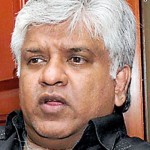
Arjuna Ranatunga
“I’m sure the helmet manufacturers will seriously look into this accident and try to do alterations. But if the helmet goes down further then the batsman will face difficulty in handling it. He will be uncomfortable and will not be able to play the game the way he wants. But here it was such a situation that any batsman would have made the same response to a delivery that Hughes faced. But unfortunately it became a rare, freak and unfortunate incident the cricketing world will never forget.”
Tissera, who never got to use a helmet as a cricketer as they were not introduced during his playing days, too was of the view that it is not the time to be critical on anything or anybody.
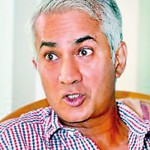
Sidath Wettimuny
“During our days we never had helmets to wear, but accidents such as this never took place. It’s because the batsmen were fully exposed with less protective gear and still because he followed the basics in cricket, they were successful. It’s not the best time to be critical of somebody but that lack of concentration, during that second ended up in costing a life. Nowadays players are careless because they have all sorts of protective gear. More than that I think players should start thinking of sticking to the basics, fully concentrating on the movement of the delivery. But it’s an unfortunate and odd happening in cricket, a total shocker,” Tissera pointed out.
Former dashing opener of the 1996 world cup winning team, Romesh Kaluwitharana gave a different mode of observation on the incident, which too came as a shocker to him. He too was of the view that the helmet has nothing to do with it.
“What I saw is that Hughes played an early shot and it also seemed that the ball did not travel at the judged pace the batsman expected. Hughes had taken all safety precautions a batsman should have when he was facing that fatal delivery. Though a bowler aims for wickets in all deliveries he will never intend to harm a batsman. I can say that through experience. What I can say is that nothing was premeditated but a shocker.”

Romesh Kaluwitharana
“As far as the helmet is concerned, it cannot and it has no more room to be altered better than how it is presently. This is a sensitive subject to discuss. We, as batsmen too have faced such deliveries during our career. Players do
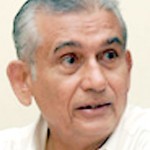
Michael Tissera
commit mistakes, and those who play with minimal of them score more while others give away their wickets. But this is totally tragic and unfortunate. While condoling the untimely loss of highly talented Philip Hughes, I think Australia should do the best they can to bring back the bowler involved, Sean Abbott. He must be going through the hardest time of his life,” the Sri Lanka ‘A’ coach said.
Hughes remained unbeaten on 63 in his knock in the game at Sydney, when his short yet glittering career and priceless life ended. Cricket Australia requested its junior cricket batsmen to retire having scored 63 this weekend, instead of the traditional retirement score of 50. Australia captain Michael Clarke, who is distressed by the incident, has made a request from Cricket Australia on behalf of the national team, that Hughes’ No. 64 ODI shirt to be retired out of respect for their departed friend and teammate.
| Touching #putoutyourbats Hughes tribute goes viral SYDNEY, Nov 28, 2014 (AFP) – Cricket bats were pictured leaning against front doors, stadiums and statues on Friday as the spontaneous #putoutyourbats tribute to fallen batsman Phillip Hughes went viral. Pictures of bats posted with the hashtag flooded Twitter as ordinary fans and star players alike joined in the touching memorial, a day after the 25-year-old’s death. West Indies legend Viv Richards was among the cricketers to contribute, and Google Australia’s home page was decorated with the simple picture of a bat. 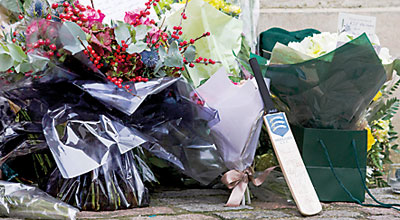 A signed miniature Middlesex CCC bat and floral tributes for Australian cricketer Phillip Hughes are pictured outside Lords Cricket Ground in London on November 28, 2014. Australia batsman Hughes, who would have turned 26 on Sunday, died on Thursday November 27, two days after being struck on the head by a bouncer while playing for South Australia against New South Wales in Sydney. AFP Previously anonymous Sydney cricket fan Paul D. Taylor, who started the campaign, tweeted that he was “amazed and humbled” by the response. He politely said “thank you, but no thank you” to media outlets requesting interviews, explaining: “#putoutyourbats isn’t about me. “It’s just a way for all cricketers to show their respects to Phillip Hughes,” Taylor wrote, under his handle @Squizabilly. “We’ve all played cricket in one way or other. Backyard or beach cricket, no matter what level we’ve all grown up with a bat and ball. This is our way to connect and show our sadness.” Tributes to Hughes, who died from head injuries on Thursday two days after taking a ball to the head while batting, were taking place throughout the sporting world. Flags flew at half-mast at Melbourne Cricket Ground and local cricket teams around Australia and India paused to observe a minute’s silence for the Australian international. Golf’s world number one Rory McIlroy, playing at the Australian Open in Sydney, had a black ribbon pinned to his cap. Pakistan and New Zealand, who called off Thursday’s play in the third Test in Sharjah, observed a minute’s silence and wore black armbands in tribute when the match resumed on Friday. Before heading out, the New Zealand players placed their bats outside the team’s dressing room with their national black caps on them to join the “#putoutyourbat” campaign. Fans of Western Sydney Wanderers planned a minute’s applause at 63 minutes — Hughes’ score when he was struck down — of Saturday’s derby match against Sydney FC. And Australia’s rugby team will wear black armbands when they play England at Twickenham on Saturday. Tennis star Rafael Nadal and New Zealand’s All Blacks rugby team were among the large and diverse group to send their condolences after the extremely rare fatality. |


